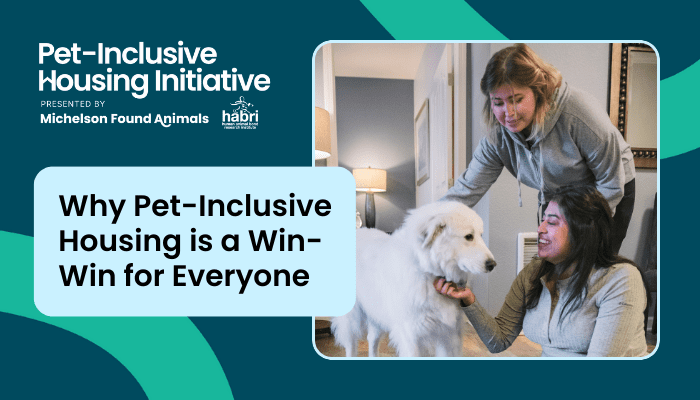MFA’s Judy Bellack Discusses Pet-Inclusive Housing on SullivanSays Podcast


By Justin Chapman
Michelson Found Animals Foundation (MFA), together with the Human Animal Bond Research Institute (HABRI), recently released their Pet-Inclusive Housing Initiative (PIHI) report, which found that rental housing owner-operators can benefit financially from enacting more pet-inclusive policies for their tenants.
Jerry Sullivan, former LA Business Journal editor who now runs SullivanSays SoCal, interviewed MFA multifamily housing industry consultant Judy Bellack for an episode of the “Making an Impact with Michelson Philanthropies” podcast series to highlight the PIHI report. Listen to the full conversation here, and read a full transcript of the conversation here.
Michelson Philanthropies is an organizational umbrella overseeing various initiatives and programs intended to “make life a little less unfair.” The multi-faceted organization was founded by Dr. Gary Michelson, a surgeon-turned-medical device inventor, and his wife, Alya Michelson, a journalist by training.
Sullivan noted that the “no pets allowed” rule is no longer necessarily the presumed default position of landlords. He asked Bellack why more people, including both renters and property owners, view pets as an integral part of their daily lives.
“We’ve really seen that change over time,” she said. “The pandemic certainly accelerated that. We saw a lot of pet adoptions in that time, and the multifamily space of real estate has adapted. Now about 76 percent of the industry now accepts some form of pet. About 20 years ago, the vast majority of properties did not accept pets, or were severely restricted. Today, the vast majority do accept pets. However, restrictions do still exist.”
Those include weight restrictions and limits on the number of pets allowed per unit, typically one, as well as a number of breed restrictions, typically anywhere from five to 15 breeds.
“As you might imagine, that starts to really create a hardship for people with their pets,” Bellack said.
Sullivan noted the general trend of increasing awareness of the value of pets and how they seem to make for better landlords and renters. He asked if they make for a better society in general as well.
“I think that they do make for a better society,” Bellack replied. “In our hearts and in our minds, if we want to see animals out of shelters, we’re going to want to talk about how everyone needs a pet and pets make everything better. But one of the things that we look at is the data around this because, particularly with the PIHI report, the data supports that as well.
“When we look at specific data surrounding multifamily, we see that fully 67 percent of renters own pets and both pet owners and non-pet owners like having pets around. The only disconnect that we see is that while 76 percent of multifamily owner-operators would say that they embrace pets and are pet friendly, 72 percent of consumers say it’s difficult to find rental housing that accepts their pets and again that goes to those weight and breed restrictions.”
“We would like to see a day where pets are truly included in all multifamily housing and rather than looking at breed or weight restrictions, multifamily owner-operators are looking at individual pets and owners and creating the right expectations for responsibilities surrounding their pet.”
—Judy Bellack, Michelson Found Animals Foundation consultant
Sullivan asked about the difference between the terms “pet-friendly” and “pet-inclusive.”
“Pet-friendly means that a single-family or multifamily development of rental homes may accept pets, while pet-inclusive takes that a step further,” Bellack explained. “When we take a look at the data surrounding multifamily, only 8 percent of units are what we would say are unrestricted. We think of inclusivity the same way we would think about that for humans. We would like to see a day where pets are truly included in all multifamily housing and rather than looking at breed or weight restrictions, multifamily owner-operators are looking at individual pets and owners and creating the right expectations for responsibilities surrounding their pet.”
Sullivan asked how rental housing operators could benefit from being more accommodating of their tenants’ pets.
“At the end of the day, they are businessmen and women, and they need to see their assets pay off,” Bellack said. “Our data shows that there are about 2.5 million pets in units who are there and unaccounted for. In other words, the owner-operator has no awareness that a pet is there. If we look at the average pet fees that owner-operators gain from having a pet in their unit, that’s about $600 a year. So if you do the math, that’s about $1.5 billion that the industry could be pulling in that they are not currently.”
Sullivan appreciates that the report complements the emotional aspects of the subject of pets with practical questions and data.
“The reason that we did this report in conjunction with HABRI is that we wanted to approach the change that we hope to create within the industry from a data-based perspective. It can’t be purely emotional. We have to be able to demonstrate that this is a good thing, a healthy thing, going forward.”
Listen to the full podcast here. To learn more, visit foundanimals.org and foundanimals.org/pets-and-housing.



